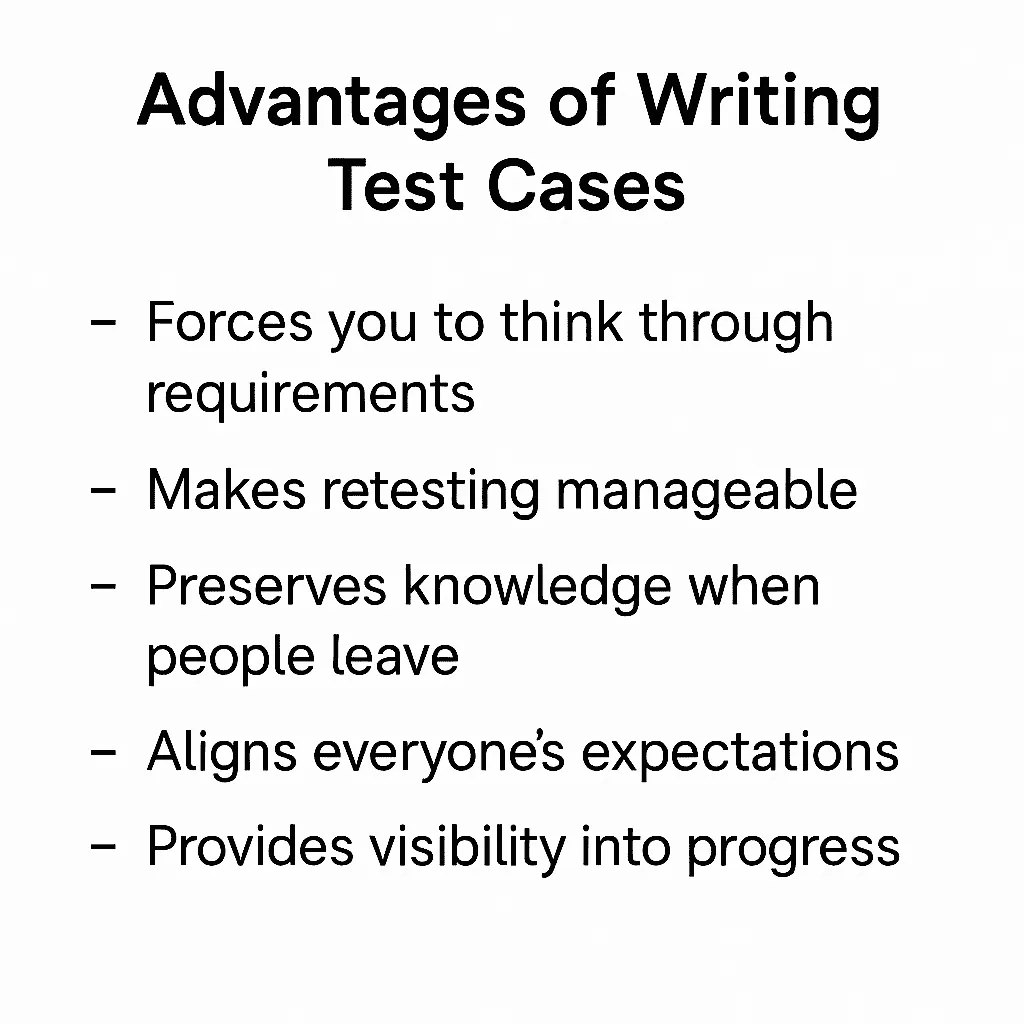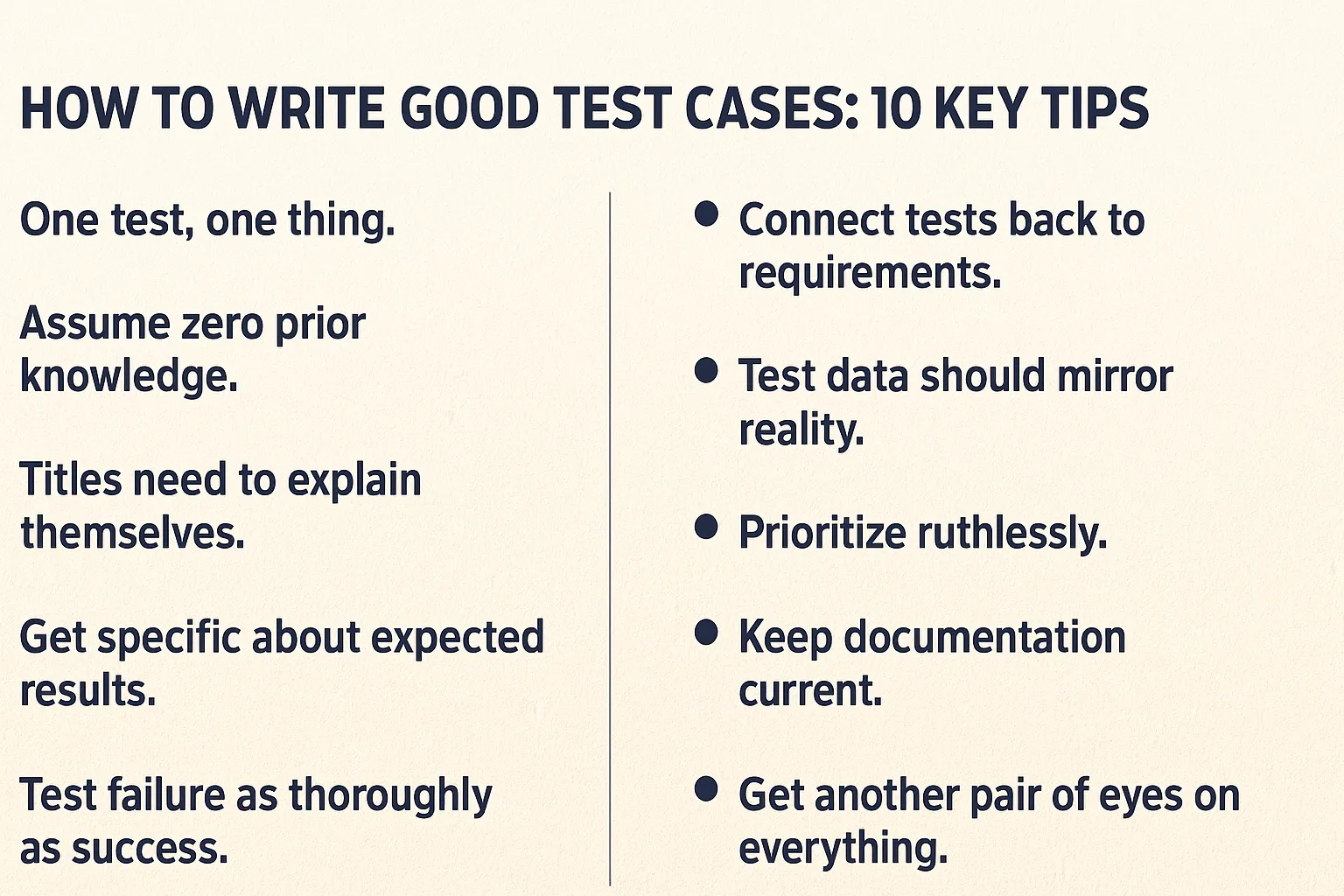Table of Contents
You know what wastes more time than anything else in QA? Test cases that don’t actually test anything meaningful. They look professional sitting in your test management system, sure. But when it’s time to run them, they’re either too vague to follow or so specific they break the moment someone changes a button color. Learning to write test cases properly matters because bad ones create this false sense of security. Your team thinks testing happened. It didn’t, not really. Modern tools like AI in QA and AI for writing test cases speed things up, but they can’t fix fundamentally flawed thinking about what needs validation.
Test case creation represents insurance. Not the boring kind, the kind that actually pays out when things go wrong. Every hour spent writing clear test cases today prevents ten hours of frantic debugging after release.
What Is a Test Case in Software Testing?
A test case tells someone exactly how to verify software behaves correctly. Picture it like cooking instructions. You need ingredients listed upfront, steps explained clearly, and a description of what the finished meal should look like. Testing works the same way. Define your starting conditions, explain what actions to take, describe what should happen.
Good documentation works for anyone on the team. Doesn’t matter if the tester executing it started yesterday or has ten years of experience. The steps should be so clear there’s no room for interpretation. Vague instructions cause problems because three different testers will execute the same test three different ways, then argue about whether it passed.
Advantages of Writing Test Cases
Solid documentation delivers value beyond catching bugs.
- Forces you to think through requirements. Can’t document how to test something you don’t fully understand. Writing everything down exposes gaps in specifications before developers waste time building the wrong thing.
- Makes retesting manageable. Code changes constantly. Without documented tests, you’re basically crossing your fingers hoping nothing broke. With them, you run the same validations after every change and catch regressions immediately.
- Preserves knowledge when people leave. Teams change. Projects get handed off. Documentation survives those transitions. New QA folks learn faster by reviewing existing tests instead of starting from scratch.
- Aligns everyone’s expectations. Developers know what gets checked. Product managers see their requirements validated concretely. Nobody’s working from assumptions that turn out wrong later.
- Provides visibility into progress. Track what passed, what failed, what’s stuck. Managers love metrics. More importantly, this data helps identify bottlenecks before schedules slip.

How to Write Good Test Cases: 10 Key Tips
Useful tests follow certain patterns. Ignore these and you’ll write documentation that looks impressive but accomplishes nothing.
- One test, one thing. Jamming multiple checks together creates diagnostic nightmares. Something fails. Was it the login? The navigation? The data entry? Nobody knows because everything ran as one giant blob. Break complex scenarios apart. Each piece gets its own validation that either passes or fails independently.
- Assume zero prior knowledge. The person running this might be brand new. List every precondition explicitly. Document every single step. Specify the expected outcome precisely. Never write “do normal setup” or “check it works” because those phrases mean nothing to someone unfamiliar with the feature.
- Titles need to explain themselves. Compare these: “Login Test 5” versus “Verify error appears when password field left blank during login.” One requires opening the test to understand it. The other tells you everything immediately. When you’re searching through hundreds of tests under deadline pressure, that difference matters enormously.
- Get specific about expected results. Writing “success message should appear” invites debate. Did it appear? Was it the right message? How long did it show? Compare that to “Green banner reading ‘Profile updated successfully’ appears at screen top for exactly 5 seconds before fading.” Now there’s no ambiguity. It either happened exactly that way or it didn’t.
- Test failure as thoroughly as success. Most teams obsess over happy paths. Enter valid data, click submit, verify success. Great. What about blank fields though? What about inputs formatted wrong? What about someone pasting a novel into a name field? Error handling breaks constantly because nobody tests it properly.
- Connect tests back to requirements. Every test should link to whatever requirement justified writing it. Requirements change. They always do. When they do, you need to know immediately which tests are now obsolete or need modification. Without that traceability, you end up with tests validating outdated behavior, which is worse than useless because it creates confusion.
- Test data should mirror reality. Placeholder garbage like “user123” and “test@test.com” won’t expose the edge cases real users hit daily. Special characters in names. Email addresses with plus signs. Phone numbers formatted differently. Your test data needs to resemble actual production data or you’re missing problems.
- Prioritize ruthlessly. Everything can’t be equally important. Payment processing deserves exhaustive testing. Button colors? Not so much. When deadlines hit and time runs short, you need clear priorities determining what absolutely must get tested versus what’s nice to have. Mark this explicitly so there’s no confusion under pressure.
- Keep documentation current. Features change constantly in agile environments. Tests documenting old behavior become dangerous because they validate the wrong things. Someone runs an outdated test, it fails, but they can’t tell if the failure indicates a real bug or just reflects that the test wasn’t updated. Regular review cycles catch this drift before it causes chaos.
- Get another pair of eyes on everything. You wrote it, so of course it makes sense to you. Show it to another tester though and watch them get confused at step three because you forgot to mention a crucial detail that seemed obvious. Peer review catches ambiguities, identifies missing scenarios, and spreads knowledge across the team so you’re not the only person who understands these tests.

Conclusion
Nobody writes perfect test cases on their first try. You’ll include too much detail in some areas, not enough in others. Steps will seem clear to you but confuse everyone else. That’s just how learning works. The difference between mediocre testers and good ones isn’t avoiding mistakes initially. It’s recognizing patterns in what goes wrong and fixing them systematically. Teams that invest properly in test case creation see concrete returns. Fewer bugs escape to production. New hires get productive faster. Releases happen more consistently. The documentation becomes institutional memory that survives people leaving and projects getting handed off to new teams.
These tips give you a foundation. Real expertise comes from noticing when your tests cause confusion or miss obvious issues, then figuring out why and adjusting your approach. Pay attention to those moments. They’re where the actual learning happens, where you develop instincts for writing effective test cases that catch problems instead of just looking impressive in your test management system.